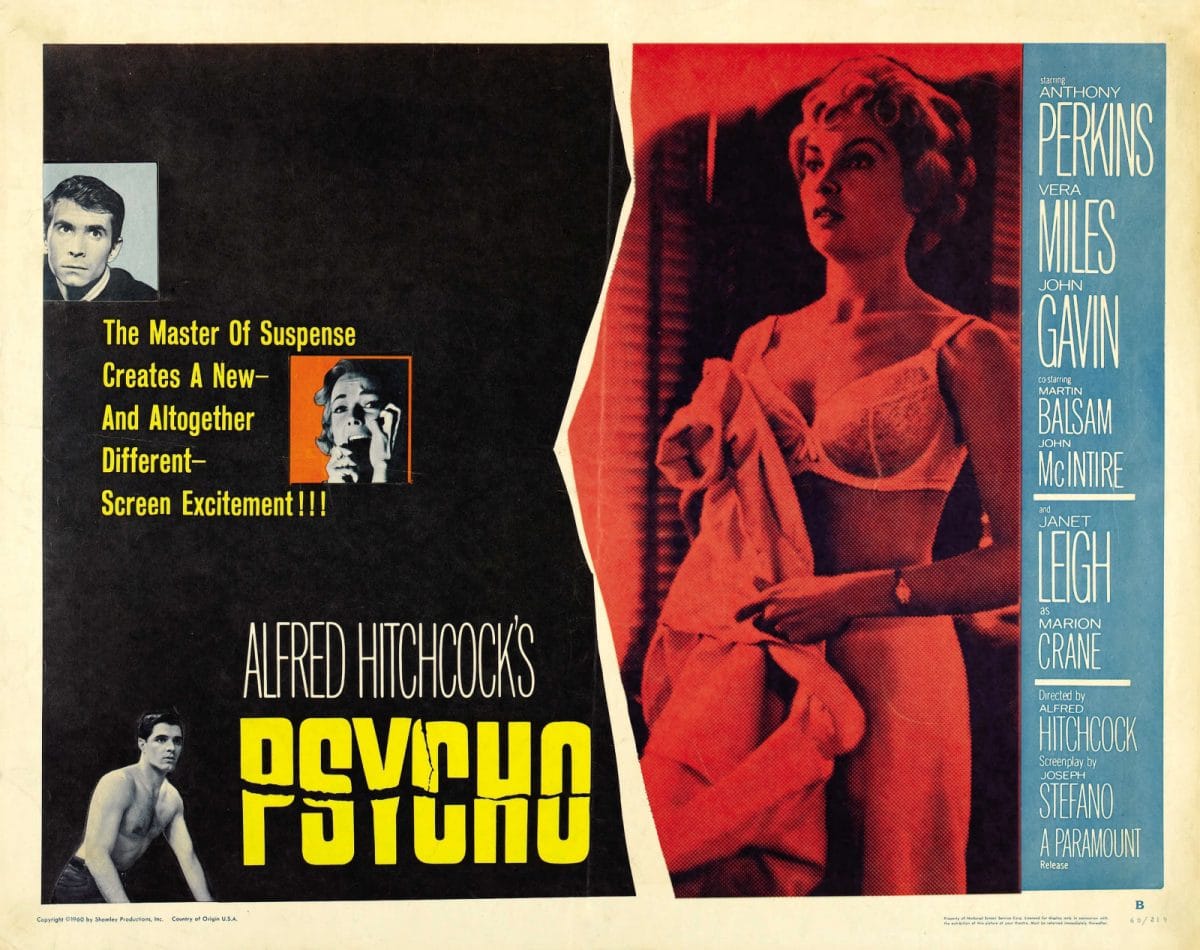
With the popularity of black and white thrillers like Henri-Georges Clouzot’s Les Diabolique (1955), master filmmaker Alfred Hitchcock wanted to do a stripped-down film full of fright and thrills. The trouble is the studio he was working with at the time, Paramount, wanted more glamorous films like his hits Rear Window, North By Northwest, and To Catch a Thief.
The director could not be dissuaded though. When his secretary found Robert Bloch’s novel, Psycho, which was loosely based on the killings of Ed Gein, the master of the macabre found his property. He bought the rights and ordered as many copies as he could be purchased and taken off stands, so it wouldn’t ruin the twist ending of the film.
Screenwriter Joseph Stefano was brought in to adapt Bloch’s thriller to the silver screen. The novel’s first chapter follows Norman Bates, an overweight, middle-aged man. This was all changed. The film was adapted to follow Marion Crane (Janet Leigh) to her fate at the Bates Motel. And the aging Norman Bates was portrayed by the younger, more attractive Anthony Perkins in his seminal role. Upon the release of the film on June 16, 1960, it became one of Hitchcock’s top-grossing hits. The director famously instructed theaters not to let audiences in after the film began.
Much more can be learned about it from my friend Stephen Rebello’s book, Alfred Hitchcock and the Making of Psycho and its adapted film, Hitchcock (2012), starring Anthony Hopkins as the master of suspense.
Written by: Joseph Stefano
Based on the book by: Robert Bloch
Directed by: Alfred Hitchcock
MITH Type: Serial Monster
MITH Cousins: Halloween, Friday the 13th, Texas Chain Saw Massacre, Peeping Tom, Scream, Psycho II, Psycho III, Psycho IV: The Beginning, Terror Train, My Bloody Valentine, Blood and Black Lace, Deep Red, Deranged, High Tension, A Bay of Blood, Sisters, A Nightmare on Elm Street, The Town That Dreaded Sundown, Prom Night, Alice Sweet Alice, Black Christmas, Strait-Jacket, Homicidal, Dementia 13, Fanatic, Die! Die! My Darling, Three On A Meathook, Schizo, Dressed to Kill
How does Psycho hit Blake Snyder’s story beats? Here is the Save the Cat!® beat sheet for the classic film:
Opening Image: After a rousing opening title sequence designed by Saul Bass and scored by Bernard Herrmann, we open on sunbaked Phoenix, Arizona. It’s Friday, December the 11th. The probing camera discovers a seedy hotel and creeps into to a partially drawn shade to an attractive couple sharing a sultry afternoon.

Set-Up: Meet Sam Loomis (John Gavin) and Marion Crane (Janet Leigh). They’re having a torrid romance on the downlow as Sam is in town from Fairvale, California on a business trip. Marion wants to marry Sam, but the hardware store owner says he’s too far in debt with his deceased father’s expenses and ex-wife’s alimony to make it work—not to mention that he lives in a storeroom in the rear of a hardware store. Marion says that she doesn’t care about his debt or living situation but Sam refuses. They’ll just have to keep meeting for a couple of years until Sam’s dire financial situation is back in the black.

Theme Stated: During their interface, Marion regrets that she has to be so surreptitious about her and Sam’s relationship: “Meeting you in secret so we can be secretive.” This is what this movie is about—secrets. And some jaw-dropping secrets will be revealed during the course of the story.
B Story: Sam Loomis is the “helper” in this film. He will help to uncover the mystery that begins in Act Two, thus revealing the secrets of the theme. Late for work, Marion returns to the office.
Catalyst: Ted Cassidy (Frank Albertson) and George Lowrey (Vaughn Taylor) arrive back in the office after closing a deal. Marion works at Lowrey’s real estate office as a secretary. Cassidy flashes a wad of cash at her—$40,000 dollars to buy his daughter a house as a wedding present (which figures to around $332,000 in today’s dollars). Cassidy is a flashy, lecherous man who makes not-so-subtle sexual advances toward Marion. Lowrey tells Marion to take the cash to the bank immediately. Marion asks to leave the office early on account of a “headache.”

Debate: In the next shot, Marion has the envelope of purloined cash on her bed and a suitcase partially packed. She’s skipping town with Cassidy’s money. She’s going to take it to Sam in Fairvale to end his financial woes so she can finally marry him. As she’s leaving town, Lowrey, who’s crossing the street, sees Marion in her car. He has a strange look on his face (since she told him she was going home early because of a headache). Does he suspect that she stole the cash?

On the highway to Fairvale, Marion has a run-in with a menacing California traffic cop (Mort Mills) after he discovers her parked on the side of the road resting. She must pull out her driver’s license from her purse that contains the envelope of appropriated bills. Does the nosy cop suspect something?

Later, Marion dumps her car in Bakersfield and trades it for another at a used car lot in an effort to “cover her tracks.” She uses $700 of the stolen money to pay the difference. She rouses suspicion from the caffeinated salesman, California Charlie (John Anderson), and the cop, who has followed her into town and is patrolling the lot. It’s clear Marion isn’t a career criminal. Acting nervous, suspicious, and hasty, she wears a guilty sign around her neck. She leaves in her new Ford Custom in haste, garnering dubious looks from the men. Are they on to her?

In a classic Debate sequence, Marion imagines voices in her head: Lowrey, Cassidy, and even her kid sister Lila, talking about her taking the money that she stole.

Break into Two: As night approaches and a sluice of rain washes across the windshield, Marion accidentally takes the wrong exit off the highway and finds herself on a dark and windy backroad. At 26 minutes, she arrives at the Bates Motel, with a foreboding California Gothic Victorian house on the hill. And an old woman pacing in front of the window. Marion’s entered the shadowy, upside-down world by choice—and it’s going to change her life forever. She honks her car horn at the empty motel for service.

Fun and Games: Norman Bates (Anthony Perkins) rushes out of the house and down the stairs. He’s a charming, boy-next-door type. He regretfully reveals to Marion that since the new highway has gone in, business is slow. Still covering her tracks, Marion signs the register “Marie Samuels,” a hybrid of her and Sam’s name and writes “Los Angeles” as where she’s from. Norman gives her the key to Cabin One which is “closer in case you want anything.”

Marion mentions the want of dinner. Norman invites her up to the house for sandwiches and milk. However, that idea is later kyboshed when Marion overhears Norman and his mother arguing from the house. The boyish motel manager returns with a tray of food and explains that “mother isn’t quite herself today.” Instead, the two dine in the shadowy parlor next to the office, which is full of stuffed birds. Taxidermy is the main hobby for Norman, who fills his empty life with it.

The polite conversation during supper turns dark when the subject wanders toward Norman’s mother. Marion suggests that he put her away in an asylum (after Norman says that she suffers from mental illness). However, Norman takes it personally, his charming and kind persona turning sharp and cold, a Jekyll and Hyde transformation—“She just goes… a little mad sometimes. We all go a little mad sometimes. Haven’t you?”
This unexpected outburst frightens Marion. She excuses herself. Norman apologizes, but Marion’s tired. During her exit, she accidentally reveals her real name and where she’s actually from, much to Norman’s private amusement.
Marion then decides to take a shower, undressing and getting ready. What she doesn’t know is that Norman, who’s still in the parlor, has a peep-hole that he’s installed into her room. He watches as she undresses with studious interest.

As Marion showers, someone enters the bathroom. It appears to be an old woman. Norman’s mother? The shadowy figure pulls back the shower curtain—and in a screech of violins provided by Herrmann on the soundtrack—Marion is stabbed to death. The assailant quickly leaves and Marion slowly crumples and dies. This shocking and iconic scene is the promise of the premise.
It’s also worth noting that this is Marion’s Final Image. She did have a transformation stealing the money to help Sam and then deciding that she was wrong to take it and to return to Phoenix. She was to redeem herself if she hadn’t been murdered by the woman with the knife.



Up at the shadowy house, Norman discovers what his mother has done. He rushes down to Marion’s room and finds her body. Completely upset and unhinged by his discovery, he decides, like a dutiful son, to cover up all traces of the murder to protect his mother from being taken away by the authorities. He wraps Marion’s corpse in a shower curtain and stuffs her in the trunk of the car.
After he mops up all the blood, he throws all of her belongings (including the $40,000 dollars that’s stuff in a folded newspaper) into the car and drives it off into the swamp behind the motel. There, he watches the car sink and disappear into the murk. Psycho is an unusual film as the star of the film dies one-third into the film and then supporting actors pick up the narrative slack—but it works!
Midpoint: A week later, Sam Loomis sits at his desk in his hardware store and writes Marion a letter. It seems he regrets not letting Marion fully into his life and into his storeroom (if he had, she’d still be alive). His letter of regrets is interrupted by Lila Crane (Vera Miles), Marion’s younger and more intense sister. She’s looking for her missing sister, who’s been gone a week. And then they’re interrupted by Private Investigator Milton Arbogast (Martin Balsam), who’s also been searching for Marion and the stolen money.
This is a going public moment of Marion’s secret crime as well as tying A and B stories together with Sam and Marion, her secret revealed. The stakes have certainly been raised. Lila becomes an extension of Marion and helps to carry on the story in her sister’s absence.

Bad Guys Close In: Arbogast believes Marion is hiding in the area and sets out to find her. His montage search leads him to the Bates Motel. Sitting on a stool on the stoop near the motel’s office, Norman looks like one of his stuffed birds eating candy corn. “This is the first place that looks like it’s hiding from the world,” Arbogast remarks of the hotel, which certainly ties into the theme of secrets.
He starts poking around and asking Norman questions about Marion, even showing him a photo. Norman denies seeing her, but his stuttering and guilty looks makes him a poor liar. Arbogast checks the motel’s register and finds the “Marie Samuels” signature and matches it to Marion’s handwriting. Now caught dead to rights, Norman admits that Marion did stay the night, but she checked in, went to sleep, and left early.

Arbogast spots the silhouette of an old woman sitting in the window of the Bates house. Arbogast inquires about her but Norman says it’s his mother and that she’s an invalid and confined. When Arbogast starts inquiring about Marion still being around, and Norman hiding her, it sets Norman off (just like in the parlor earlier with Marion). Bates blurts out “she may have fooled me but she didn’t fool my mother.” This, of course, piques the detective’s interest. He now wants to speak with Norman’s mother. Norman denies it and Arbogast would have to get a court order to do so, so he leaves. Norman seems happy that he “bested” the detective.

Arbogast calls Lila from a payphone. He tells her that Marion stayed at the Bates Motel and that she stayed in Cabin One (based on Norman not wanting to go into that room when he was changing bed sheets). The detective isn’t satisfied. Norman clearly wasn’t telling him everything and he believes the mother is the key to the case. He’s going to return and speak to her.

The insistent detective returns. Norman spots him and hides in the shadows. Arbogast searches around the office for Bates, even checking the safe in the parlor for the cash. Nothing. He sets off up the hill to speak to Mrs. Bates. Inside the house, it’s out of date by about 70 years, last decorated in the 1890s—all Victorian, like a time capsule. As the detective ascends the stairs, a crazed woman with silver hair attacks him, slashing his face with a butcher’s knife. The wounded Arbogast plummets down the stairs. And like an angel of death, Mrs. Bates is upon him, finishing the job with stabs of the blade.

Lila and Loomis wait back at his hardware store for Arbogast to return. Of course, he doesn’t. His corpse has joined Marion’s at the bottom of the murky swamp. The detective said he’d return in “an hour or less.” It’s been three. Lila wants to drive out to the old highway; she’s coming out of her skin. Sam goes instead, telling Lila to stay behind in case Arbogast shows up.
Wandering around the grounds of Bates Motel, Sam calls for Arbogast. Norman, who stands out in the back of the swamp, obviously just dumping the detective into his watery grave, ignores Sam’s calls, a dark look on his face.
All Is Lost: Sam returns to the hardware store to the waiting Lila. No Bates. No Arbogast. No money. And no answers. They’re worse off than they were before. It’s a dark time in a dark hardware store. Who can help?

Dark Night of the Soul: Sam takes Lila to see Deputy Sheriff Al Chambers (John McIntire) and Mrs. Chambers (Lurene Tuttle) for assistance. Sam quickly explains the situation. The rustic old sheriff tries to calm them down by telling them the detective probably took off with a hot lead to the case. Lila says no, he called when he was dissatisfied; he would have called if had something. She says he wanted to talk to Mrs. Bates. Norman took a wife? No, his mother. This gets strange looks from the Chambers.
The sheriff calls out to the motel and briefly speaks with Norman, who says that the detective never returned. Chamber then says Norman Bates’ mother died ten years ago. She had a lover. When she found out he was married, she allegedly poisoned him and herself. Norman found them together in bed. Mrs. Chambers says she even picked out the burial dress. So, Sheriff Chambers asks the question that thickens the plot: “Well if the woman up there is Mrs. Bates, who’s that woman buried out in Green Lawn Cemetery?”


Back in his parlor at the Bates Motel, Norman contemplates what to do. With the local sheriff now calling him, the heat is on. He shuts down the office and heads up to the house. He needs to talk to mother about all of this. As he confronts her, they get into an argument. He wants to hide her down in the fruit cellar “just for a few days” until this whole thing will blow over. She refuses. Norman won’t take no for an answer, he scoops up his mother’s frail body and carries her down the stairs into the bowels of the house.

Sunday morning. Sam and Lila meet Sheriff Chambers and his wife after church. They ask if they can go out to the Bates Motel with the sheriff. He says that he already went before the morning service. Norman showed him the register and that he’s alone. There’s no mother, what Sam must have saw up in the window was an illusion. Sam and Lila still aren’t convinced. The sheriff tells them to report a missing person with regards to Marion but that still doesn’t satisfy Sam or Lila. And so…



Break into Three: … Sam and Lila take the law into their own hands, so to speak, by going to the creepy motel out on the old highway themselves. They decide to register as man and wife, and then when Norman Bates isn’t around, to search every inch of the place until they find out what happened to the missing Marion, tying A and B stories together.

Five Point Finale:
1. Gathering The Team – Sam and Lila decide to storm the castle: the Bates Motel. They check in. But since Norman saw Sam Loomis when he came out earlier, he’s onto them, especially when they’re a traveling “married couple” with no bags. The lonely proprietor plays along though, putting them as far from Room One as possible.
2. Executing the Plan – Sam and Lila manage to sneak into Cabin One. They discover there’s no shower curtain and a figure on a piece of paper added or subtracted from $40,000 didn’t get washed down the toilet (when Marion tried to flush it down).

Believing the old house on the hill and the mother hold the answers to Marion’s fate, Lila decides she’s going up there. Sam will have to run interference with Bates. Lila searches the house, finding it empty with no mother, but strange things, like the effigy of a figure in a bed in one position. Norman’s room is like that of a small child’s—evidence of inhibited emotional and psychological development.

Back at the motel, Sam grills Norman for answers about Marion and the money. Norman fights back. Then when he realizes that Lila is probably poking around his house, he fights with Sam, knocking him out and…
3. High Tower Surprise – … Norman runs up to the house to stop Lila from discovering his deepest darkest secrets. Seeing Norman mounting the stairs up the side of the hill, Lila retreats to the cellar, the only place she hasn’t checked out.
4. Dig Deep Down – Lila has a macabre shock when she finds Mrs. Bates, her back to Lila down in the fruit cellar. When Lila turns around the “resting” woman, she discovers that she has rotted away, only a frail corpse.

Lila screams. Norman Bates thunders down the stairs—now wearing his mother’s dress over his clothes, a gray wig, and wielding a sharp butcher’s knife. He proclaims that he’s Norma Bates.

5. Executing the New Plan – When Norman/Norma go to attack Lila, Sam comes to her aid, grabbing the garbed killer and disarming the knife. Bates is defeated.

Inside the courthouse, Sam and Lila, thanks to psychiatrist Dr. Fred Richman (Simon Oakland), discover what happen to Marion and the money. “Norma” Bates admitted all the wrong-doing of her son—telling about the murders of Marion and Detective Arbogast, as well as two missing girls.
It seems that poisoning his mother and her lover drove Norman mad. He began taking on his mother’s personality, thinking and speaking for her. He began dressing up as her to further the illusion that his mother was still alive, as well as stealing her corpse and attempting to preserve it via taxidermy.

Final Image: Norman sits in his cell, but it’s Norma who narrates. He’s crossed over psychologically and now he’s his mother. Norman will be put away in the place he was trying to keep his mother away from: the sanitarium. His transformation is now complete.

And Marion’s car, in the swamp, is unearthed from the muck. The final mystery solved. All secrets revealed.

Don Roff
2 Comments
Leave a Reply Cancel reply
You must be logged in to post a comment.










Having at the age of fifteen first seen Psycho a few days after it’s mid-June opening in NYC, it immediately and forever affected me. The milk and sandwiched scene is particularly haunting. A movie buff with eclectic tastes, I continue at the age of seventy-three considering Psycho as my all-time favorite film. Rather than ever bored or disappointed by many repeat viewings over almost six decades, I’m forever impressed by all aspects of what remains for me absolutely exquisite movie making. Bravo and thanks to Alfred Hitchcock et al.
My favourite too. I think the sandwiches scene is the best-written part, without even taking into account the incredible set design, camera angles, performances, and, of course, Bernard Hermann’s stunning score.